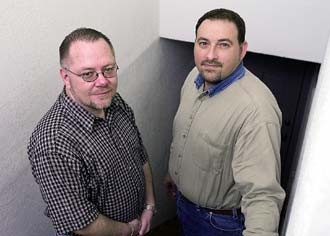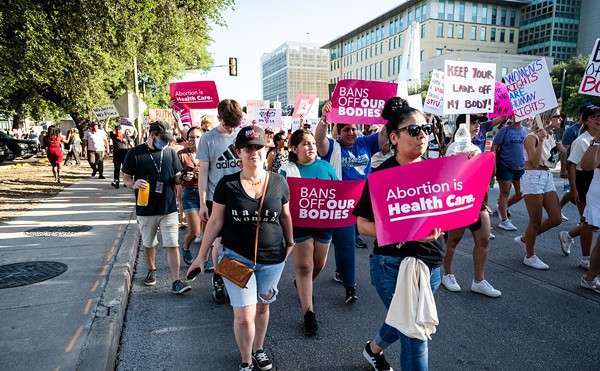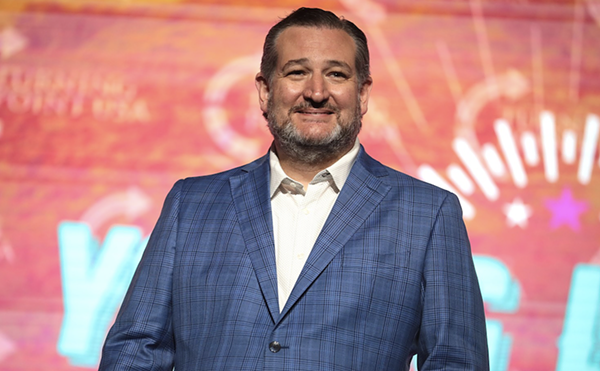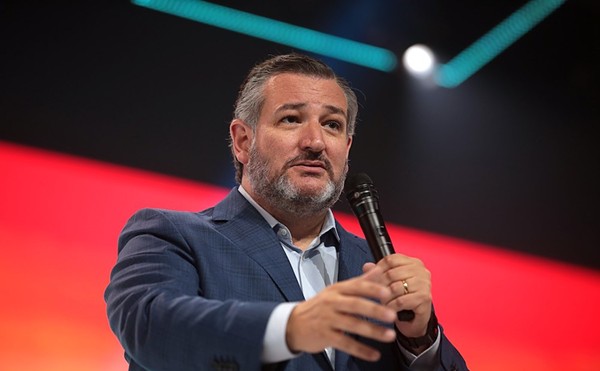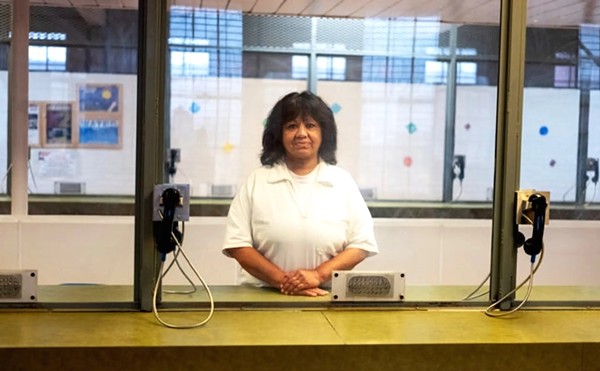| Gay and Lesbian Community Center board members Nathan Javine (left) and Michael Weaver. (Photo by Mark Greenberg) |
As January draws to a close, most people are abandoning their New Year's resolutions. But the new Board of the Gay and Lesbian Community Center of San Antonio is just starting with their future plans. The obstacles are high: Like any nonprofit organization, the GLCCSA is trying to brainstorm ways to expand their programs as funds are evaporating. The Board has a past of "not mistakes, but learning experiences," as interim executive director Tino Romero explains. And while individual Board members each have his or her own ideas for the direction that the Center should take, the focus, for the time being, is on staying afloat.
The GLCCSA is the only full-time community center of its nature in Texas, according to Romero, and its programs span the gamut from HIV testing, counseling, support groups, social events, and a monthly newsletter. The Center also functions as a gathering point for the GLBT community - where people go for referrals to find gay-friendly doctors and businesses, and the place to which other social services agencies refer people in need. "We don't turn away anybody," Romero explains. And from the basement of the Metropolitian Community Church, where the Center is located, a small staff of three tries to meet the rising demands of the GLBT community of San Antonio - on an annual budget of $80,000.
The majority of the Center's money comes from a federal Center for Disease Control grant, for subcontracting HIV testing and other services for Hope Action Care network, a local social services group. The grant reimburses about $40,000 of the Center's costs, and they make up the rest in donations, $100 or $200 at a time. "At this point," explains Nathan Javine, the secretary of the Board, "We are running on the CDC grant, and funneling the operations of pretty much everything through the grant." But the grant is very specific, as Board Chair Michael Weaver notes; it's designed to combat the spread of AIDS in young gay men of color. Programs that don't fall under that purview are paid for by donations alone, and as Romero notes, "as everybody knows, donations have really dropped since 9-11."
The Board is concerned that its CDC grant might not be renewed in the upcoming years. It's a legitimate concern, but not one that is specific to the Center alone. Jesus Sanchez, Chief Executive Officer of the Hope Action Care network, explains that with nationwide budget cuts, programs that benefit gays are under attack: "Because of politics, the CDC is having to be very careful about the projects that they fund." Essentially, the Center has to prove to the CDC why its projects deserve funding - or face cuts. But, Sanchez is quick to note, the CDC "are bending over backwards to give us the chance to prove ourselves and keep this funding. They are in no way being an ogre about this." The Center needs to come up with "something more concrete than what they are giving to us," Sanchez explains, or else the Hope Action Care network will be forced to find other local subcontractors.
| "I feel that there is a lack of emphasis on people of color, on lesbians, on single moms ... maybe I can do something to steer them in the right direction." - Deb Martin, GLBT board treasurer |
The Center's main goal is starting a capital campaign to fund an expansion to a new building , out from the basement of the Church, where they lease about 4,000 square feet. It's clear that volunteers have done their best to brighten up the small space, with posters, rugs, and books lining the walls. But there simply isn't enough space for private counseling sessions or group meetings. Other issues the Board plans to tackle in the upcoming year are those of diversity, explains Deb Martin, the new treasurer. "Overall, the center, considering the resources that they have, they do pretty good. But when you talk about diversity, personally, I feel that there is a lack of emphasis on people of color, on lesbians, on single moms ... maybe I can do something to steer them in the right direction."
Securing funding from the general public, however, can be tricky when the GLBT community is divided. As Martin explains, "You know, there is only so much money that is going to be available to the community. ... It makes it difficult to approach business `for donations` if these situations are going on. It doesn't reflect well on the community. It's counterproductive to what we're trying to accomplish." •

